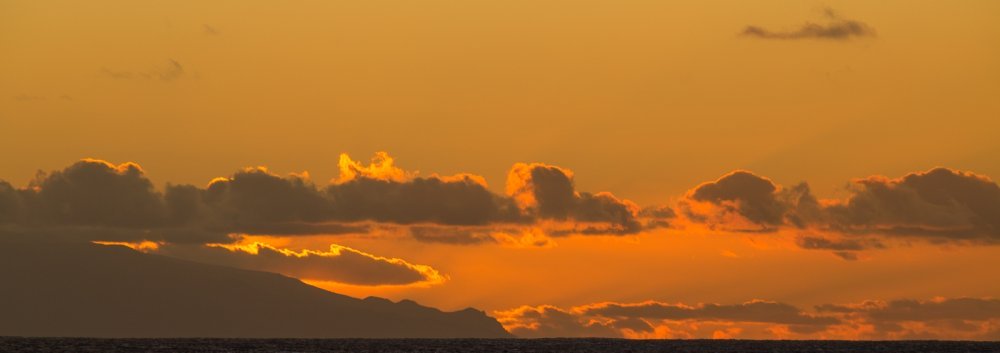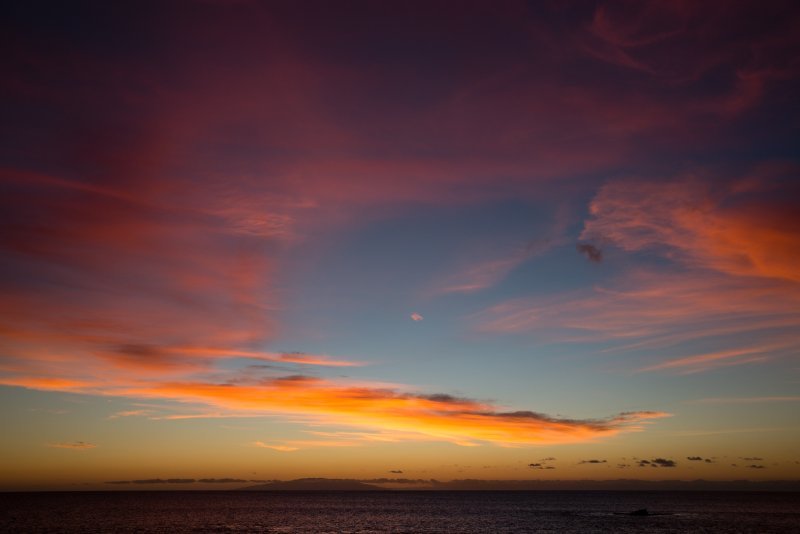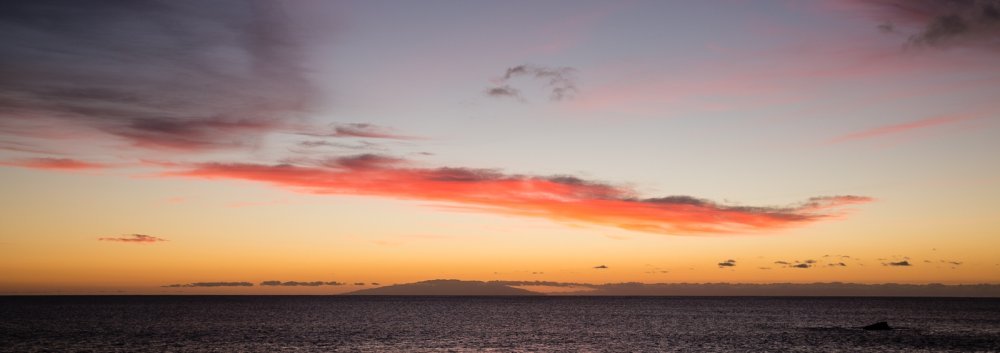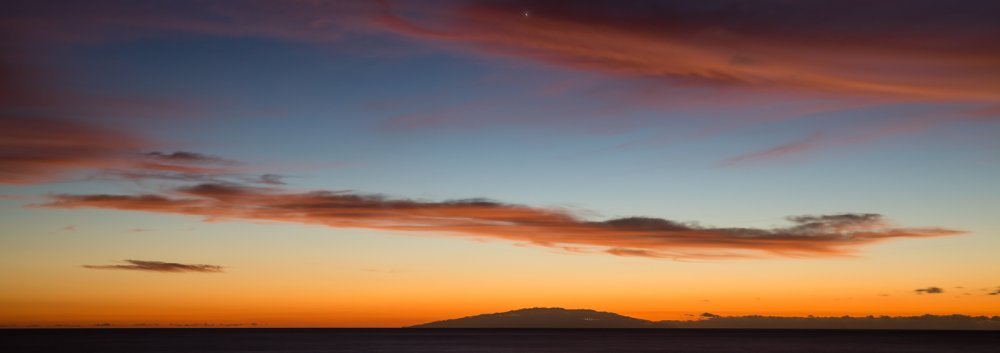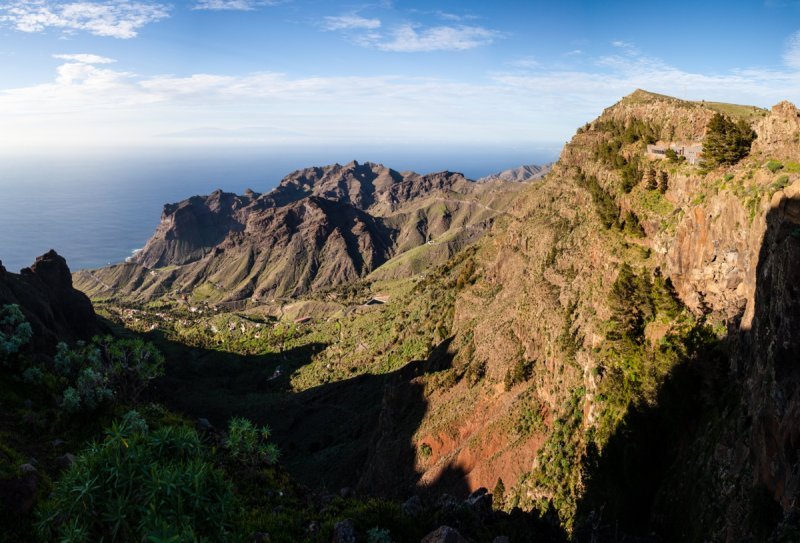I am finally getting round to add some posts to my photo blog from our trip to Symi last July. In this first post, two night shots (taken a few days apart) of the wonderful view to Hinari from our balcony. A wonderful view that we enjoyed with a glass of wine every night before heading out for dinner during our two weeks stay.
Category: Travel
La Gomera is literally littered with little chapels, or ermitas as they are called locally in Spanish. So where ever you are in the dramatic landscape on the island, there is always one nearby, whether hidden deep inside the laurel forest, or prominent with 360˚ panoramic vistas on top of the high ridges or in the shadow of towering cliffs deep down in the dramatic barancos.
Here are two striking little ermitas set in the dramatic landscape of Tagaluche: Ermita de San Salvador in the shadow of the towering cliffs of Galión (above) and a little Ermita and graveyard in the shadow of Lomo del Viento (below), both taken from Risco de Heredia.
The villages on top of La Gomera are widely known as the cloud villages, with Las Hayas, El Cercado and Chipude being the famous trio, situated more than 1000m above sea level in the heart of the island. Some days these villages are basking in sunlight, other days they are obscured completely by clouds. Irrespective of the weather, these villages are a joy to explore by foot, with a drink in a local cafe as a treat at the end.
One of our favourite short walks on La Gomera starts at Montana de Destene, just down from Dolgelada de Parazza on the GM-3 to Playa Santiago. In the bend, shortly before Jerdune, you can drive onto the rough old road and park where the old road swings back on itself and the walking route down to Playa Santiago and El Cabrito start. The first stretch of this well marked long distance route round Roque de Berruga to Alto de Tacalcuse makes for an extremely rewarding, easy morning or afternoon walk.
The path meanders along the ridge and round Roque de Berruga with superb views to all sides, from the impressive Heights of La Montañeta to the West, the majestic Barranco de Chinguarime and towering Alto de Tacalcuse to the South and Roque de Magro and Roque de Sombrero on the other side of Barranco Juan de la Guancua to the East as you can see in my post Colourful Jerdune from 2010.
What makes this walk even more special for us are the tranquility of the location and the derelict finca’s that are scattered along the ridge and down the steep South Westerly slope of Roque de Berruga. Exploring these finca’s is a must, especially those a bit away from the beaten track of the long distance walking route. On our previous visit a few years earlier, this finca had a locked door and an intact roof. Now the door is blown of it’s hinges, and the roof has partly caved in.
As promised in my last post with the little egret, here are some photos of the whimbrel (numenius phaeopus).
Seeing the whimbrel scurry along the rocky shore was a daily delight. It was hard to spot though, as it is very fast moving. One second you see it, then it disappears behind a rock, and before you know it, it appears again several metres along. After watching it for a few days from the balcony, the birds daily routine became obvious. It would fly in and start on the rocky shore to the left or the right of the rocky sweep before us, then scurry along the rocks to the other side, before flying off again.
One morning, I spotted it on far on the right, starting it’s move. So I grabbed my camera, rushed down and headed to the left. I sat down on the stairs leading down from the the pavement to the rocky shore and patiently waited. Within minutes I spotted it, and it was, as expected, heading my way meandering through the rocks. Due to a fairly high tide, the whimbrel was close and it’s lateral move past me gave me the opportunity I had been waiting for.
I suspected it to be a curlew, so I had a look on the internet and found lots of images that seemed to confirm my thought, it possibly being the slender billed curlew. On returning home I consulted the Birds of the Atlantic Islands. It turns out to be a whimbrel (numenius phaeopus), a regular to the Canary islands especially in winter, and not the slender billed curlew, a very rare vagrant visitor. The small dark crown divided by median strip was the tell tale sign.
Wildlife and birdlife is fairly sparse on La Gomera, especially in the winter. But for those keeping their eyes peeled, there are still some special birds to be seen. While staying in La Puntilla, with a view from our balcony directly onto the rocky shore, an egret and a whimbrel were a daily delight. Amazingly, the tourist walking along the shore were completely oblivious of their presence.
It was wonderful (and relaxing!) to just watch these birds looking for food while wandering along the rocky shore and dodging the incoming waves. The egret looks predominantly for fish in the incoming waves, while the curlew spends his energy poking its long beak in the holes in the volcanic rocks, looking for little crustaceans. Unfortunately, both were mostly too far away to get any decent photos.
One morning, with a lot of patience and careful negotiation around some large volcanic rocks to remain out of view, I managed to get close enough to take a couple of photos of this lovely little egret, before it was scared away by the tourists congregating on the pavement along the shore, wondering what I was up to with that big camera and lens.
I will share some photos of the whimbrel in the next post.
One of the highlights of our stay in La Gomera over Christmas and New Year were, without a doubt, the spectacular sunsets over El Hiero. Nothing is more relaxing than to sit on the balcony of our apartment in Puntilla with a glass of vino tinto and watch the sun slowly disappear before going out for dinner.
This post shows the sunset on Xmas day, starting with a bright amber sky over El Hiero at 18:19 with the sun just about gone, followed by the clouds slowly turning bright red, starting with the clouds overhead within 10 minutes and slowly moving to the clouds on the horizon another 5 minutes later.
As soon as the sun has disappeared, the crowds watching the sunset from the shore below start to head home, not knowing that they are about to miss the best part of the day’s sunset. Had they had the patience to wait another 20 minutes, they would have witnessed the strong orange glow on the horizon ending the day’s sunset in an absolute fantastic finale.
Time to finish the glass of vino tinto and head down to Christie’s for our Christmas dinner.
At 18:19
At 18:29
At 18:35
At 19:00
While walking back from a late afternoon drink at El Charcoal, a nearly full moon was peering out at us over the towering cliffs of Teguerguenche. Without having to move much, I was able to capture the moon aligned with the little dip in the rock face.
The 20:20 vision below shows how little the moon actually is to the scale of the towering cliffs, noting that less than half the cliffs hight is visible in this image.
This is the view from Ermita de Igualero across the Barranco de Erque to the magnificent rock fortress La Fortaleza after the devastating forest fires ravages the heart of the island. In October 2007, the same view would yield a spectacular green valley as you can see below, flanked by thriving laurel forests on the right.
There are no words that can begin to describe the loss of the laurel forest reduced to a marsian landscape by forest fires.
Unfortunately, the difference between these two images is even worse considering that the above was taken after an unusual wet two months rainy season and that the below was taken at the end of a very dry summer.
The devastation to the island is immense.
The fires on La Gomera this summer have been absolutely devastating to the unique laurel forest as well as the local communities with loss of live, homes and livelihood. Just an afternoon’s drive across the roof of the island through the Parque National de Garajonay (a Unesco Heritage Site) and through the cloud villages of Las Hayas, Chipude and El Cercado. Sadly, the extend of the devastation is even worse than we anticipated with very large areas of forest completely burnt and vineyards completely blackened.
Here are the first a pair of before and after images. This is one of the most famous landmarks on La Gomera, the impressive Roque Agando. The one after the fire (above) was taken this Christmas (2012) and the one before the fire (below) was taken in 2006.
Due to the heavy autumn rains, ground growth is adding a little fresh green to a completely blackened forest and barren ground, but the trees will likely take a decade or even more to regenerate.
The elephant stampede through the little village of Pinnawala can be witnessed several times in a single day when the elephant orphans are moved from their grazing grounds to the river and back.
We arrived when the elephants were feeding on the higher ground. We admired the baby orphans being fed with a bottle and the larger elephants feeding on the greens laid out for them on the plains.
Then we headed to down to the river, sitting on the terrace overlooking the river with a fresh mango juice. It wasn’t long before the stampede through the village started and the herd of elephants trampled into the river for a cool down.
Watching the elephants visibly enjoying the paddle in the river and spraying themselves with water was just wonderful. And the couple of mischievous little ones trampling about was just fantastic. And it was nice to see that apart from just two of elephants, absolutely none of the big herd of orphans were chained.
When we go back to Sri Lanka, we will, without a doubt, return to the orphanage for a lunch overlooking the river, as it was the highlight of our holiday. Absolutely magical.
